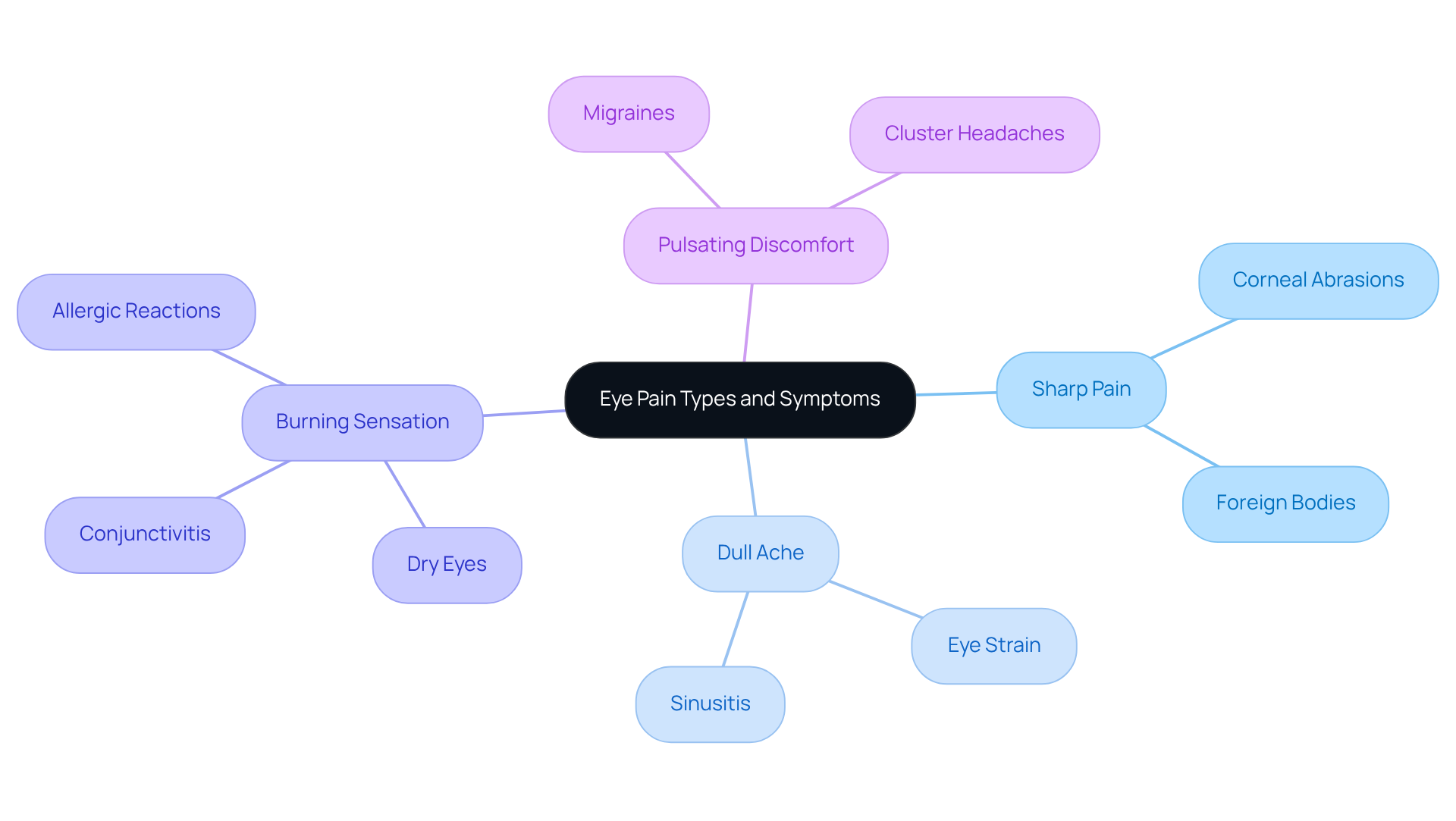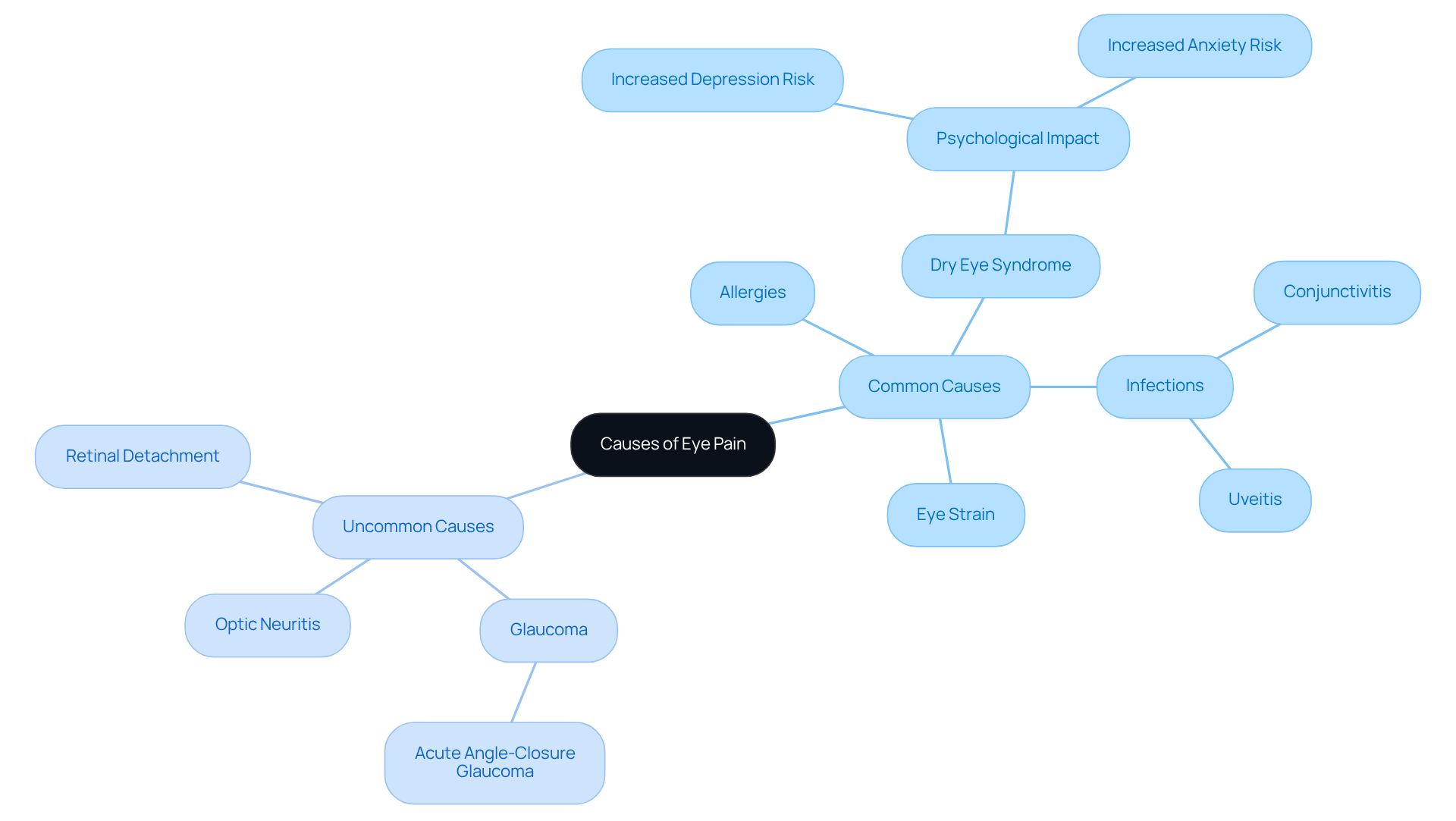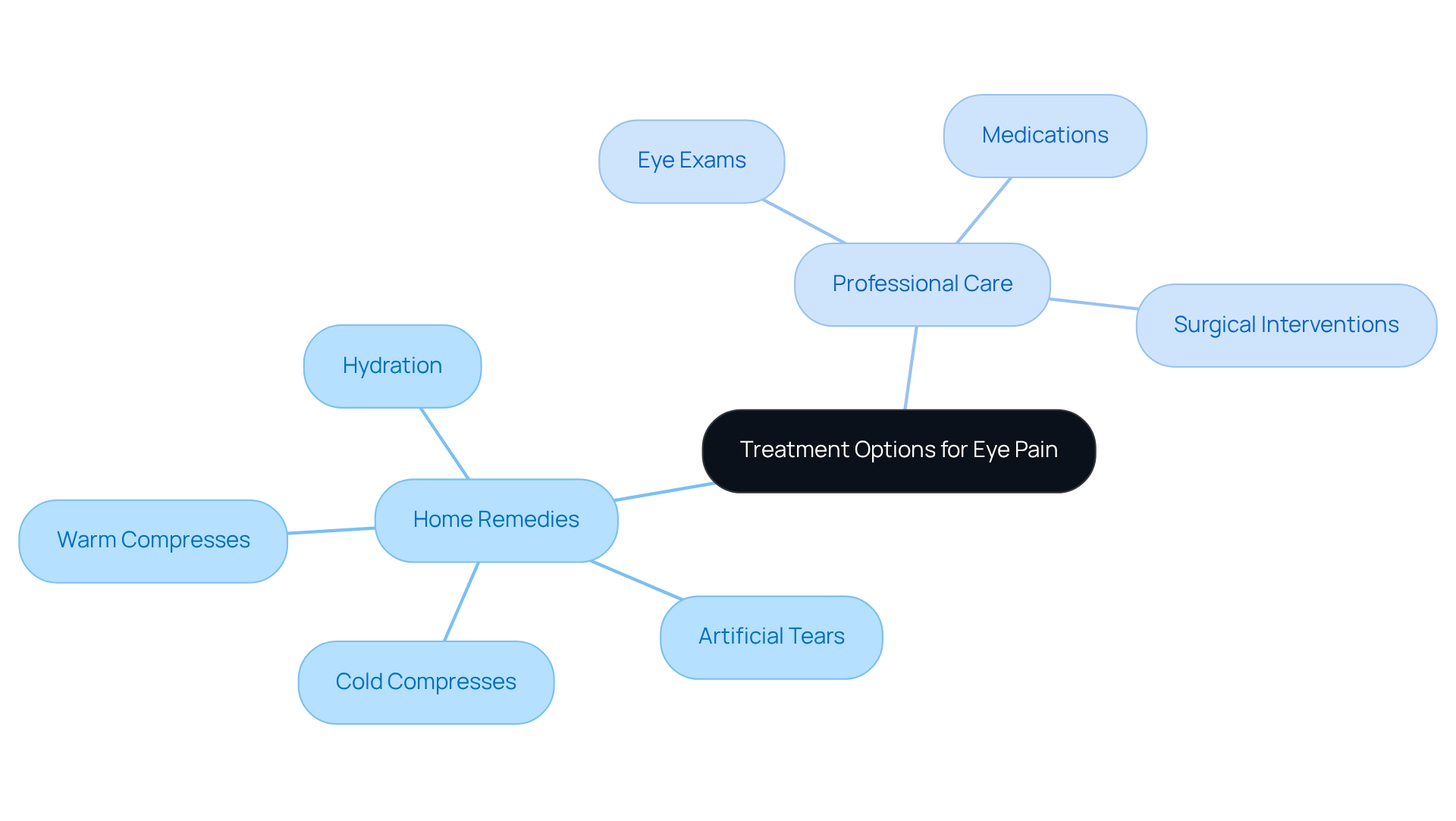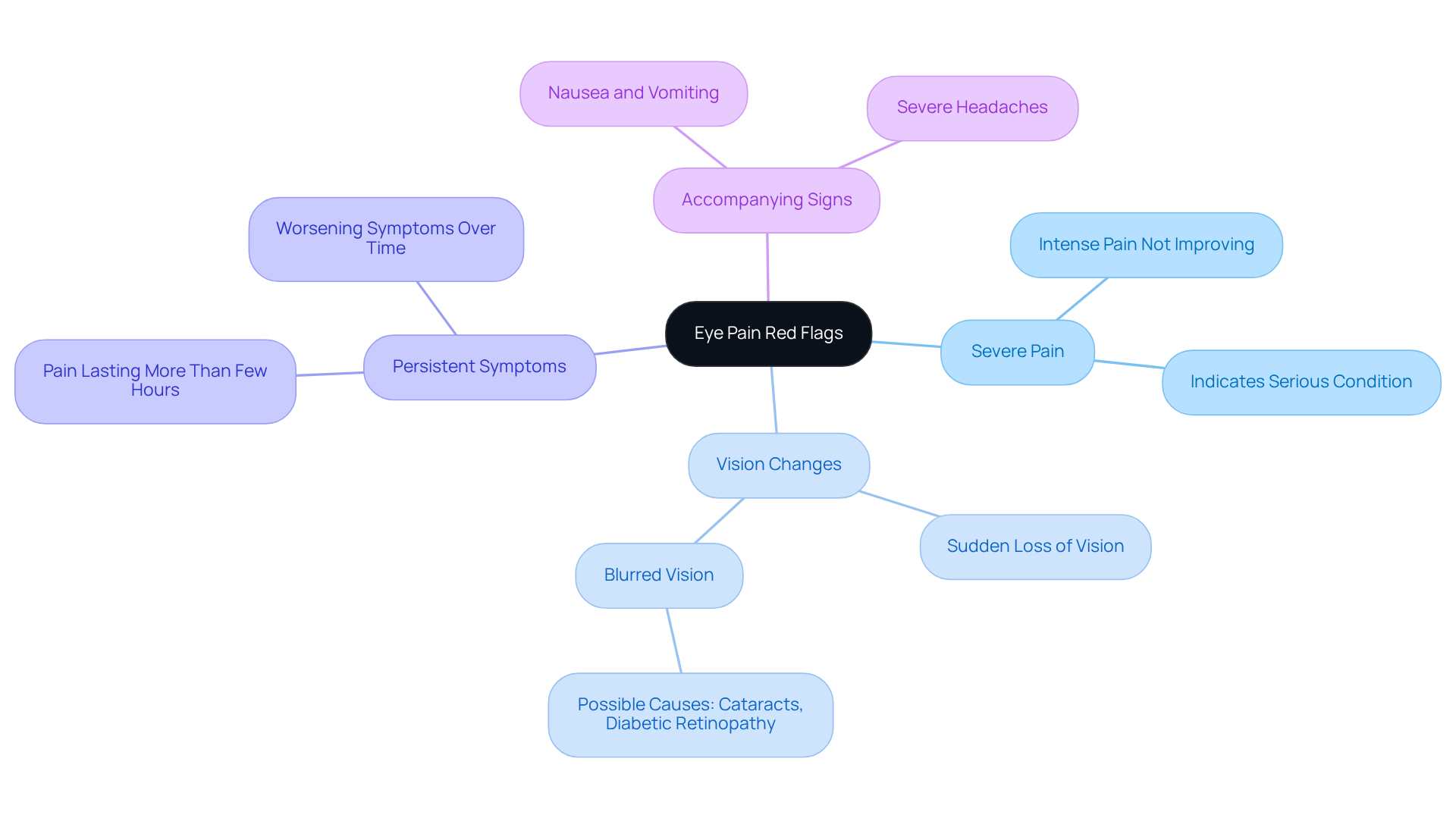Posted by: Northwest Eye in General on July 20, 2025
Overview
Experiencing eye pain in one eye can be concerning, and it’s important to know that various causes may be at play, such as:
- Dry eye syndrome
- Infections
- Eye strain
Each of these conditions presents unique symptoms that deserve careful attention. We understand that recognizing these symptoms can be overwhelming, but seeking timely medical attention for severe or persistent pain is crucial.
It’s common to feel anxious about what this discomfort might mean. Exploring treatment options can provide relief and reassurance. Whether considering home remedies or professional care, there are effective ways to address your discomfort. Remember, you are not alone in this journey, and we are here to help you through the process.
Introduction
Experiencing eye pain, especially when it’s localized to one eye, can understandably evoke feelings of urgency and concern. This discomfort may reflect a range of potential underlying issues, and it’s important to recognize that it can vary from benign conditions like dry eye syndrome to more serious ailments such as glaucoma or retinal detachment.
We understand that navigating eye health can be overwhelming, and you may be wondering when it’s time to seek medical attention and what treatment options are available. This exploration into the causes, symptoms, and remedies for eye pain in one eye aims to empower you with the knowledge needed to address your concerns effectively.
Remember, we are here to help you through this process and ensure you receive optimal eye care.
Define Eye Pain: Types and Symptoms
Eye discomfort can manifest in various forms, and recognizing the type is crucial for identifying the underlying cause. We understand that in one eye can be distressing, and it’s important to know that you’re not alone. The primary types of eye pain include:
- Sharp Pain: Often linked to conditions such as corneal abrasions or the presence of foreign bodies in the eye, sharp pain can indicate immediate issues requiring prompt attention.
- Dull Ache: This type of discomfort may suggest issues like eye strain or sinusitis, often resulting from prolonged screen time or inadequate lighting.
- Burning Sensation: Commonly associated with dry eyes, allergic reactions, or conditions like conjunctivitis, a burning sensation can significantly impact comfort and vision.
- Pulsating Discomfort: Usually an indication of migraines or cluster headaches impacting the eye area, pulsating discomfort may also occur with other systemic indicators.
Symptoms associated with eye discomfort often include redness, swelling, sensitivity to light, and changes in vision. It’s common to feel overwhelmed by these symptoms. For example, a study showed that more than 5 million visits to healthcare professionals each year are attributed to eye discomfort, emphasizing the commonality of these issues. Furthermore, around 2.4 million eye injuries happen each year in the United States, highlighting the significance of identifying signs of eye discomfort and the necessity for protective eyewear.
Conditions such as dry eye disease, keratoconus, and conjunctivitis can lead to significant discomfort and should be evaluated by a professional. Understanding these indicators is essential for patients to seek appropriate care and ensure timely intervention, particularly in cases where conditions like uveitis may be present. We encourage you to pay attention to your body’s signals. Implementing strategies such as the 20-20-20 rule can help alleviate eye strain, while staying hydrated is important for maintaining eye moisture and preventing dryness. By understanding the nuances of eye discomfort, individuals can better navigate their eye health and enhance their overall well-being. Remember, we are here to help you through this process.

Explore Causes of Eye Pain: Common and Uncommon Factors
Eye discomfort can be a result of various causes, including eye pain in one eye, which can range from benign to serious. We understand that experiencing discomfort, particularly , can be concerning, and recognizing these factors is crucial for knowing when to seek further evaluation. Here are some common and uncommon causes that may resonate with your experience:
Common Causes:
- Dry Eye Syndrome: Insufficient tear production can lead to discomfort and pain. Research indicates that individuals with dry eye are significantly more likely to experience psychological distress, with a 1.65 times higher likelihood of developing depression and a 1.62 times higher chance of anxiety. Additionally, dry eye syndrome can cause eye pain in one eye and affects an estimated 4.1 million Americans, highlighting the importance of recognizing symptoms and seeking timely medical attention.
- Allergies: Allergic reactions can cause itching and burning sensations, often exacerbated by environmental triggers.
- Infections: Conditions such as conjunctivitis and uveitis can lead to considerable discomfort. In cases of conjunctivitis, inflammation of the conjunctiva can cause eye pain in one eye, along with redness and discomfort, necessitating careful diagnosis to rule out more serious conditions.
- Eye Strain: Prolonged screen time or reading can lead to fatigue and discomfort, commonly referred to as digital eye strain.
Uncommon Causes:
- Glaucoma: Increased intraocular pressure can cause severe pain and vision loss. Acute angle-closure glaucoma, in particular, requires immediate medical attention to prevent permanent damage.
- Optic Neuritis: Inflammation of the optic nerve can result in discomfort, especially during eye movement, and is often linked to multiple sclerosis.
- Retinal Detachment: A serious issue that may arise with sudden discomfort and changes in vision, necessitating immediate action to maintain sight.
Recognizing these causes, including symptoms like eye pain in one eye, can empower you to seek timely medical care, ensuring that serious conditions are addressed promptly. If you are facing intense eye discomfort, eye redness, or any warning signs, please remember that seeking prompt medical attention is essential. We are here to help you through this process.

Identify Treatment Options: From Home Remedies to Professional Care
Treatment for eye pain in one eye is tailored to the underlying cause, encompassing a range of options that include both home remedies and professional care. We understand that experiencing in one eye can be distressing, and we’re here to help you through this process.
Home Remedies:
- Warm Compresses: These can effectively soothe discomfort associated with dry eyes or minor irritations, promoting relaxation and relief.
- Artificial Tears: Studies indicate that artificial tears are beneficial for alleviating symptoms of dry eye syndrome, providing moisture and comfort. Regular use can significantly improve eye hydration and reduce discomfort.
- Cold Compresses: Perfect for alleviating swelling and discomfort from allergic reactions, cold compresses can offer instant relief and assist in controlling inflammation.
- Hydration: Aim for at least eight glasses of water a day to keep your eyes and body well-hydrated, which is essential for maintaining overall eye health.
Professional Care:
- Eye Exams: Comprehensive eye examinations are essential for accurately diagnosing the cause of pain, allowing for targeted treatment strategies.
- Medications: Depending on the diagnosis, prescription eye drops or oral medications may be necessary to address infections or inflammation effectively.
- Surgical Interventions: In instances involving ailments such as cataracts or glaucoma, surgical alternatives may be necessary to ease discomfort and restore vision, ensuring long-term eye health.
It’s common to feel overwhelmed when dealing with eye pain in one eye, so consulting with an eye care professional is crucial for determining the most appropriate treatment based on your individual circumstances. As Dan T. Gudgel emphasizes, “See a doctor or go to the emergency room as soon as possible if you can’t get the particles out of your eye or if it still feels like there’s something in your eye after you’ve gotten the material out.” Timely intervention can result in improved outcomes, especially for more severe issues.

Recognize Red Flags: When to Seek Medical Help for Eye Pain
If you’re experiencing eye pain in one eye, it’s important to recognize specific symptoms that may require immediate medical attention. We understand that this can be concerning, and identifying these red flags is essential for your well-being:
- Severe Pain: If you’re feeling intense pain that doesn’t improve with home remedies, it may indicate a serious underlying condition needing professional evaluation.
- Vision Changes: Sudden loss of vision or blurred vision can be critical signs of eye issues that require prompt attention. Blurred vision, in particular, may stem from conditions like cataracts, diabetic retinopathy, or uncorrected refractive errors—each of which necessitates a thorough assessment by a Northwest Eye doctor.
- Persistent Symptoms: Pain that lasts more than a few hours or worsens over time should not be overlooked. It’s common to feel anxious about these symptoms, such as eye pain in one eye, but they may suggest a more serious issue.
- Accompanying Signs: Additional symptoms such as nausea, vomiting, or severe headaches can indicate complications like iritis or glaucoma, which also require immediate medical attention.
If you encounter any of these signs, such as eye pain in one eye, seeking prompt medical assistance is crucial to prevent possible complications and ensure appropriate treatment. With over in the U.S. for eye pain, representing approximately 0.39% of all outpatient visits and 0.61% of all ED visits per year, understanding these warning signs can lead to timely care and better outcomes. Remember, we are here to help you through this process. Northwest Eye also offers educational resources like the Eye Condition Library and symptom checkers to assist you in recognizing these symptoms effectively.

Conclusion
Experiencing eye pain in one eye can be a concerning issue that requires careful attention and understanding. We understand that this discomfort can be unsettling, and it’s important to explore the various types of eye pain, their potential causes, and the treatment options available. By recognizing specific symptoms and knowing when to seek medical help, you can take proactive steps towards managing your eye health effectively.
Key points discussed include the different manifestations of eye pain, such as:
- Sharp discomfort
- Dull discomfort
- Burning discomfort
- Pulsating discomfort
Each type is linked to various underlying conditions. Common causes like dry eye syndrome, allergies, and infections were highlighted, along with more serious conditions such as glaucoma and retinal detachment. Treatment options range from home remedies like warm and cold compresses to professional care involving medications and surgical interventions. It’s essential to tailor these approaches based on your individual circumstances.
Ultimately, understanding eye pain in one eye is crucial for maintaining overall eye health. It’s common to feel anxious about these symptoms, but being vigilant and seeking timely medical attention when necessary can make a significant difference. By staying informed and proactive, you can navigate the complexities of eye discomfort and ensure a healthier future for your vision. We are here to help you through this process.
Frequently Asked Questions
What are the main types of eye pain?
The primary types of eye pain include sharp pain, dull ache, burning sensation, and pulsating discomfort.
What does sharp eye pain indicate?
Sharp pain is often linked to conditions such as corneal abrasions or foreign bodies in the eye and may require immediate attention.
What causes dull eye ache?
A dull ache may suggest issues like eye strain or sinusitis, often resulting from prolonged screen time or inadequate lighting.
What conditions are associated with a burning sensation in the eyes?
A burning sensation is commonly associated with dry eyes, allergic reactions, or conditions like conjunctivitis.
What does pulsating discomfort in the eye usually indicate?
Pulsating discomfort is usually an indication of migraines or cluster headaches impacting the eye area.
What symptoms are associated with eye discomfort?
Symptoms often include redness, swelling, sensitivity to light, and changes in vision.
How common are visits to healthcare professionals for eye discomfort?
More than 5 million visits to healthcare professionals each year are attributed to eye discomfort.
What is the significance of eye injuries in the United States?
Around 2.4 million eye injuries happen each year in the United States, highlighting the importance of identifying signs of eye discomfort and the necessity for protective eyewear.
What conditions should be evaluated by a professional for eye discomfort?
Conditions such as dry eye disease, keratoconus, and conjunctivitis can lead to significant discomfort and should be evaluated by a professional.
What strategies can help alleviate eye strain?
Implementing strategies such as the 20-20-20 rule and staying hydrated can help alleviate eye strain and maintain eye moisture.






